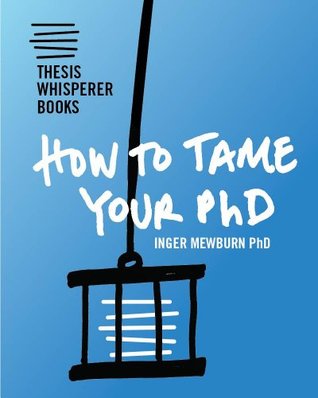More on this book
Kindle Notes & Highlights
‘threshold concept’: this insight once grasped was unforgettable.
It could be that you are facing a threshold concept without realising it.
a thesis is a claim or defence
articulate a position on ‘the literature’
develop a theory or a model which allows the findings to be used, or applied to other cases.
You may become stuck because you need to unlearn certain ways of doing things.
Sometimes you don’t have to know what the outcome of a process will be – you just have to do it and see what happens.
Writing messily means you produce a lot of excess that has to be pared back.
Thesis panic is caused by what seems like an impossibly large and difficult project coupled with a fast approaching deadline.
"Keep regular hours" one person said to me at a party - "and write everyday". "Treat your supervisor like a boss"
In my job for example, my manager and I set out in writing an agreement at the start of each year what projects I will be involved in and what the deadlines are.
just fill in the blanks: • “The evidence about________ shows that__________” • “The findings of ____________have important consequences for the broader domain of ________” • “The standard way of thinking about ___________ has it that_______” • “____________ for instance, demonstrates_________________” • “In making this point I am challenging the common belief that __________”
One reason that writing is such a good thinking tool is that it encourages us to think in a linear fashion, one word in front of the other.
many people find they can only sustain a linear mode of writing for about 1500 words. Certainly
Too much editing at the initial drafting stage is, more often than not, the enemy of Done.
This diagramming method enables me to find relations between the ideas and the authors that I am reading - great for lit reviews.
Humans don’t think don’t think like typewriters
It’s helpful to start by working smaller pieces in parallel and then work out how they go together.
It’s hard to be messy in a clean way
It’s hard to change my mind
Research is not just about words
Research writing involves analysing information, synthesising it and crafting it into new forms.
Information appears in the form of words, diagrams, tables and images. Often I want to see these as I write so I can do the ...
This highlight has been truncated due to consecutive passage length restrictions.
Death by Feature
not to worry too much about how stupid your ideas look the first time you put them on paper.
"Just remember, there's no such thing as writing: only rewriting"
Step one: spend less time at your desk
a limited time frame in which to do it.
So dedicate less than a quarter of the day to making some new text and then take a break and return later to clean it up.
Step Two: remember the two-hour rule
Most of us are in the best frame of mind for this after breakfast and before lunch
Writing new stuff should be almost the first thing you do when you sit down to your desk.
Step Four: start in the middle
"Writing for Social Scientists,” said: "How can I introduce it if I haven't written it yet?"
Step Four: Write as fast as you can, not as well as you can
Do this 'free writing' in bursts of about 10 to 15 minutes. When you need a rest, review and fiddle with the text - maybe plant a new seed - then move on to another burst.
Step Five: leave it to rest... then re-write
take a break before you attempt this, or you wont have the necessary perspective.
do try to pull some 'finished words' - even if it's only a paragraph - back into your draft each day.
1. Decide on the task to be done 2. Set the pomodoro (timer) to 25 minutes 3. Work on the task until the timer rings 4. Take a short break (5 minutes) then do another burst 5. Every four "pomodori" take a longer break (15–20 minutes)
one thing I recommend all students do sometime in second year is to write an examiner profile.
Write a one sentence summary describing your examiner's current academic position • What sort of things does my examiner already know about my topic? • What is my examiner interested in theoretically? • What methods does my examiner like to use? • What might my examiner expect to learn from reading this thesis? • What annoys my examiner?
finding out what you need to say and working out how do you need to say it.
would suggest that you start by doing a basic audience analysis.
a common magazine trick is to use easy to read panels alongside the text.
who are your audiences and how might you re-purpose - or redraw - this diagram for them?
Academics, Surowiecki claims, are particularly prone to procrastination, perhaps because of the largely self-directed nature of their work.
outside pressure to counteract the inner urge to put off the job.
I suppose this is why the imposition of deadlines on PhD students is ultimately a good thing. You don’t have to defer the responsibility to your institution either; creating your own deadlines within candidature and agreeing on them with your supervisors is good strategy for overcoming the urge to delay writing.
I could try closing my eyes and imagining that elusive state of 'flow', the state of being at one with the work of writing, which is pleasurable in and of itself.


